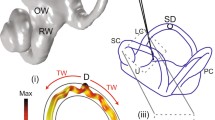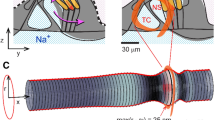Abstract
Patients with superior canal dehiscence (SCD) suffer from events of dizziness and vertigo in response to sound, also known as Tullio phenomenon (TP). The present work seeks to explain the fluid-dynamical mechanisms behind TP. In accordance with the so-called third window theory, we developed a computational model for the vestibular signal pathway between stapes and SCD. It is based on first principles and accounts for fluid–structure interactions arising between endolymph, perilymph, and membranous labyrinth. The simulation results reveal a wave propagation phenomenon in the membranous canal, leading to two flow phenomena within the endolymph which are in close interaction. First, the periodic deformation of the membranous labyrinth causes oscillating endolymph flow which forces the cupula to oscillate in phase with the sound stimulus. Second, these primary oscillations of the endolymph induce a steady flow component by a phenomenon known as steady streaming. We find that this steady flow of the endolymph is typically in ampullofugal direction. This flow leads to a quasi-steady deflection of the cupula which increases until the driving forces of the steady streaming are balanced by the elastic reaction forces of the cupula, such that the cupula attains a constant deflection amplitude which lasts as long as the sound stimulus. Both response types have been observed in the literature. In a sensitivity study, we obtain an analytical fit which very well matches our simulation results in a relevant parameter range. Finally, we correlate the corresponding eye response (vestibulo-ocular reflex) with the fluid dynamics by a simplified model of lumped system constants. The results reveal a “sweet spot” for TP within the audible sound spectrum. We find that the underlying mechanisms which lead to TP originate primarily from Reynolds stresses in the fluid, which are weaker at lower sound frequencies.

















Similar content being viewed by others
References
Aibara R, Welsh JT, Puria S, Goode RL (2001) Human middle-ear sound transfer function and cochlear input impedance. Hear Res 152(1–2):100–109
Andrews DG, McIntyre ME (1978) An exact theory of nonlinear waves on a Lagrangian-mean flow. J Fluid Mech 89(4):609–646
Benner CF (2015) Fluid-dynamic study of sound-induced vertigo. Master thesis, Institute of Fluid Dynamics, ETH Zürich, doi:10.3929/ethz-a-010395756
Boluriaan S, Morris PJ (2003) Acoustic streaming: from Rayleigh to today. Int J Aeroacoust 2(3):255–292
Bradley C (2012) Acoustic streaming field structure. Part II. Examples that include boundary-driven flow. J Acoust Soc Am 131(1):13–23
Carey JP, Minor LB, Nager GT (2000) Dehiscence or thinning of bone overlying the superior semicircular canal in a temporal bone survey. Arch Otolaryngol Head Neck Surg 126(2):137–147
Carey JP, Hirvonen TP, Hullar TE, Minor LB (2004) Acoustic responses of vestibular afferents in a model of superior canal dehiscence. Otol Neurotol 25(3):345–352
Chien W, Rosowski JJ, Ravicz ME, Rauch SD, Smullen J, Merchant SN (2009) Measurements of stapes velocity in live human ears. Hear Res 249(1–2):54–61
Cremer P, Minor L, Carey J, Della Santina C (2000) Eye movements in patients with superior canal dehiscence syndrome align with the abnormal canal. Neurology 55(12):1833–1841
Curthoys IS, Oman CM (1987) Dimensions of the horizontal semicircular duct, ampulla and utricle in the human. Acta Otolaryngol 103(3–4):254–261
Edom E, Obrist D, Kleiser L (2014) Steady streaming in a two-dimensional box model of a passive cochlea. J Fluid Mech 753:254–278
Gautier F, Gilbert J, Dalmont JP, Picó Vila R (2007) Wave propagation in a fluid-filled cylindrical membrane. Acta Acust 93:333–344
Gerstenberger C, Wolter FE (2013) Numerical simulation of acoustic streaming within the cochlea. J Comput Acoust 21(4:1350019):1–37
Grieser B (2015) Fluid-mechanical model for vestibular responses to sound in presence of a superior canal dehiscence. PhD Thesis, ETH Zürich, Dissertation No. 22681, available online
Grieser B, McGarvie LA, Kleiser L, Manzari L, Obrist D, Curthoys IS (2014) Numerical investigations of the effects of endolymphatic hydrops on the VOR response. J Vestib Res 24(2–3):219
Grieser B, Kleiser L, Obrist D (2015) tullioFoam—a numerical model of the Tullio phenomenon. ETH E- Collections ETH Zürich, doi:10.3929/ethz-a-10435235
Gueta R, Levitt J, Xia A, Katz O, Oghalai JS, Rousso I (2011) Structural and mechanical analysis of tectorial membrane Tecta mutants. Biophys J 100(10):2530–2538
Hallauer WM (1974) Nonlinear mechanical behavior of the cochlea. PhD Thesis, Stanford University
Hornung HG (2006) Dimensional analysis: examples of the use of symmetry. Dover Publications Inc, Mineola
Huber A, Linder T, Ferrazzini M, Schmid S, Dillier N, Stoeckli S, Fisch U (2001) Intraoperative assessment of stapes movement. Ann Otol Rhinol Laryngol 110(1):31–35
Kaski D, Davies R, Luxon L, Bronstein AM, Rudge P (2012) The Tullio phenomenon: a neurologically neglected presentation. J Neurol 259(1):4–21
Kim N, Steele CR, Puria S (2013) Superior-semicircular-canal dehiscence: effects of location, shape, and size on sound conduction. Hear Res 301:72–84
Korteweg DJ (1878) Über die Fortpflanzungsgeschwindigkeit des Schalles in elastischen Röhren. Ann Phys 241(12):525–542
Kringlebotn M, Gundersen T (1985) Frequency characteristics of the middle ear. J Acoust Soc Am 77(1):159–164
Küttler U, Wall W (2008) Fixed-point fluid–structure interaction solvers with dynamic relaxation. Comput Mech 43(1):61–72
Lesser MB, Berkley DA (1972) Fluid mechanics of the cochlea. Part 1. J Fluid Mech 51(3):497–512
Lighthill J (1978) Acoustic streaming. J Sound Vib 61(3):391–418
Lighthill J (1992) Acoustic streaming in the ear itself. J Fluid Mech 239:551–606
Minor LB (2000) Superior canal dehiscence syndrome. Am J Otol 21(1):9–19
Minor LB (2005) Clinical manifestations of superior semicircular canal dehiscence. Laryngoscope 115(10):1717–1727
Minor LB, Solomon D, Zinreich SJ, Zee DS (1998) Sound-and/or pressure-induced vertigo due to bone dehiscence of the superior semicircular canal. Arch Otolaryngol Head Neck Surg 124(3):249–258
Minor LB, Cremer PD, Carey JP, Della Santina CC, Streubel SO, Weg N (2001) Symptoms and signs in superior canal dehiscence syndrome. Ann N Y Acad Sci 942(410):259–273
Niesten MEF, Stieger C, Lee DJ, Merchant JP, Grolman W, Rosowski JJ, Nakajima HH (2015) Assessment of the effects of superior canal dehiscence location and size on intracochlear sound pressures. Audiol Neuro Otol 20(1):62–71
Obrist D (2011) Fluid mechanics of the inner ear. Habilitation treatise. ETH Zürich, Zürich. doi:10.3929/ethz-a-007318979
OpenFOAM Foundation (2015) OpenFOAM project web page. http://www.openfoam.org. Accessed 7 Feb 2015
Pisano DV, Niesten MEF, Merchant SN, Nakajima HH (2012) The effect of superior semicircular canal dehiscence on intracochlear sound pressures. Audiol Neuro Otol 17(5):338–348
Rabbitt RD, Boyle R, Highstein SM (1999) Influence of surgical plugging on horizontal semicircular canal mechanics and afferent response dynamics. J Neurophysiol 82(2):1033–1053
Riley N (2001) Steady streaming. Annu Rev Fluid Mech 33(1):43–65
Rosowski JJ, Songer JE, Nakajima HH, Brinsko KM, Merchant SN (2004) Clinical, experimental, and theoretical investigations of the effect of superior semicircular canal dehiscence on hearing mechanisms. Otol Neurotol 25:323–332
Songer JE, Rosowski JJ (2007) A mechano-acoustic model of the effect of superior canal dehiscence on hearing in chinchilla. J Acoust Soc Am 122(2):943–951
Van Buskirk WC, Watts RG, Liu YK (1976) The fluid mechanics of the semicircular canals. J Fluid Mech 78(01):87–98
von Békésy G (1960) Experiments in hearing. McGraw-Hill, New York
Womersley JR (1955) Method for the calculation of velocity, rate of flow and viscous drag in arteries when the pressure gradient is known. J Physiol 127(3):553–563
Acknowledgments
The work of B. Grieser was supported by the Swiss National Science Foundation (SNSF, Grant No. 205321-138298). The authors would like to thank Prof. J. Dual for helpful remarks, C.-F. Benner for his support in the course of a master’s thesis (Benner 2015), and Dr. S. Hegemann for introducing them to the Tullio phenomenon.
Author information
Authors and Affiliations
Corresponding author
Ethics declarations
Conflict of Interest
The authors declare that they have no competing interests.
Rights and permissions
About this article
Cite this article
Grieser, B.J., Kleiser, L. & Obrist, D. Identifying Mechanisms Behind the Tullio Phenomenon: a Computational Study Based on First Principles. JARO 17, 103–118 (2016). https://doi.org/10.1007/s10162-016-0553-0
Received:
Accepted:
Published:
Issue Date:
DOI: https://doi.org/10.1007/s10162-016-0553-0




